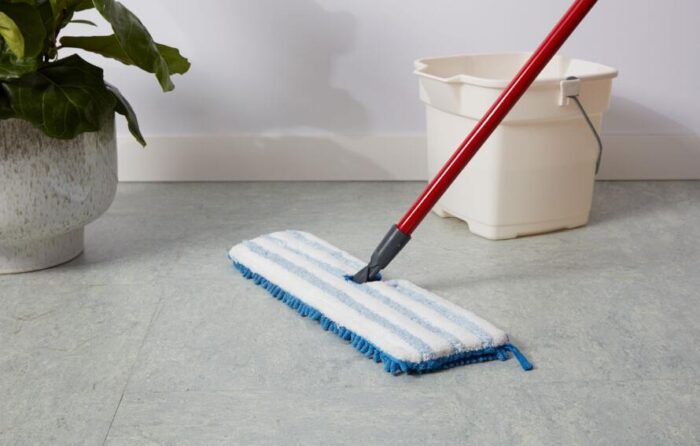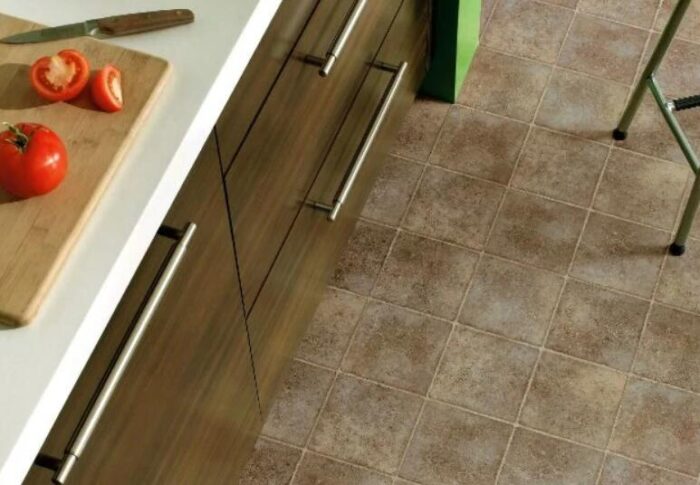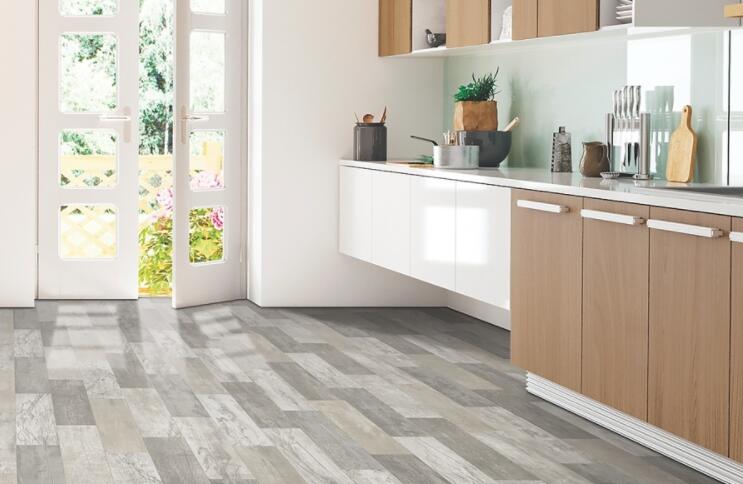Linoleum has become quite popular in the recent past due to its ability to withstand the toughest stains. Although Linoleum flooring is designed to withstand the test of time, regular cleaning helps maintain its longevity and strength.
Now, understand that linoleum floors are not as durable as other options in the market, such as vinyl. You, therefore, must take extra care when cleaning this flooring. You must avoid harsh chemicals that could ruin the shine of the linoleum flooring.
In this article, I will take you through everything you need to know about how to clean linoleum floors.
Follow this detailed guide to ensure that you enjoy your linoleum floors for years and decades to come.
How to Clean Linoleum Floors?
Step 1: Remove dirt from the floor
The first step to the cleaning process requires you to remove excess dirt on the surface. Dust mop, sweep, or vacuum the linoleum floor and focus on the hard-to-reach areas.
Ensure that you clean underneath the cupboards, cabinets, and appliances.
Step 2: Mix a natural cleaning solution
Fill your cleaning bucket about half of the way with lukewarm water. Add an equal amount of white vinegar.
However, note that there is no exact measurement of the water to vinegar ratio. You probably won’t need an entire bucket of cleaning solution for your linoleum floor.
You should never use more water than you need. Understand that standing water may damage your floor. Your best bet would be to use a gallon of lukewarm water, one cup of vinegar, and a little dish soap.
Alternatively
Now, you could always use a cleaning product that is specifically designed for linoleum floors. These chemical solutions are found in home department stores.
Most of these cleaners have to be diluted with water, which means that you have to read the manufacturer’s instructions.
Chemical solutions designed for linoleum floors will disinfect and clean your floors better than the vinegar solution. However, stay away from other cleaning products such as ammonia because they will damage your floors.
Step 3: Mop the floor
Dip your mop into the cleaning solution and wring out all the excess solution. Understand that your mop needs to be damp but not dripping wet. The best way to mop up the entire floor is by dividing it into sections.
When you want to clean the floors more effectively, try using a soft-bristled scrub. However, you will need to work on your knees if you decide to use a scrub brush.
Step 4: Rinse the floor
When using the vinegar solution, you don’t need to rinse your linoleum flooring. This is because the vinegar solution will evaporate along with all the smells.
It is, however, essential that you rinse the floor if you used a cleaning product.
Dump out the bucket and refill it with clean water. Dip your mop into the fresh, clean water and rinse your entire floor.
Work in sections to ensure that you rinse every inch of your floor. Cleaning solutions have to be rinsed because they will attract dirt and dust.
How to Clean Yellowed Linoleum?
Over time, linoleum floors start turning yellow, especially after a lot of spills or waxing.
Waxing is a great idea when you want to keep your floor looking bright and shiny. However, wax usually traps dust and dirt particles that will lead to the yellowing of your floor.
Dealing with yellowed linoleum is not as difficult as you might think. All you need is water, baking soda, and a soft cloth.
- Start by removing all the dirt in the affected areas.
- Now, wet these areas with plain water and sprinkle a little bit of baking powder over the affected areas.
- Ensure that you let it sit for about 15 minutes.
- Use your clean, soft cloth to wipe the baking soda away from the yellowed areas. You will notice that the baking soda easily removes the yellow color from your linoleum flooring.
However, note that you might need several applications to remove all the yellow stains. You might have to repeat the process a few times before you get the desired results.
You must exercise patience when handling the stubborn yellow stains on your linoleum flooring.
How to Deep Cleaning Linoleum Floors?
Deep cleaning is necessary now and then to help restore your linoleum floors to their natural beauty. With deep cleaning, you get to remove those stubborn dirt particles that are embedded in the surface of your floor.
You need to perform a deep cleaning on linoleum flooring either annually or semi-annually. Below are some of the materials that you will need:
- Vacuum cleaner
- Bucket
- Microfiber mop
- Hot water
- Soft-bristled brush
- Baking soda
- Old towels
- Mild dish soap
Step 1: sweep or vacuum
Start by removing all the dirt and dust particles on the floor by either sweeping or vacuuming. However, when you decide to use a vacuum cleaner, ensure that you change the setting to clean hard surfaces.
Most people usually have the vacuum cleaner set to clean carpets, which might not be effective on your linoleum floor.
Step 2: Sprinkle baking soda
Proceed to sprinkle baking powder on the entire floor. Understand that baking powder will help you get rid of the stubborn yellow stains on your linoleum floor. You, therefore, need to let it settle for about 15 minutes.
Step 3: Mix cleaning solution
Mix one cup of vinegar, a gallon of hot water, and drops of soap dish in a cleaning bucket. Ensure that you have enough cleaning solutions for your entire floor. Using a natural cleaning solution gives your linoleum flooring more longevity.
Step 4: Mop your floor
Use the cleaning solution to mop your entire floor. Use the soft-bristle brush when dealing with stubborn dirt. The high traffic areas will also require you to use the brush for a more thorough cleaning.
Using the brush will force you to get on your knees and use your hands. The good news is that you don’t have to do this daily.
Step 5: Rinse the floor
Use a bucket of clean water to rinse your entire floor. This step ensures that you remove all traces of the soap or baking soda residue on your floor. You can then finish up by drying the floor using the old towels.
How to Make My Linoleum Floors Shine?
Linoleum floors lose their shine after a few years. The good news is that they are quite durable, and you can always restore the shine. Well, let us take a look at the steps involved in restoring shine to your linoleum flooring.
Step 1: Wash your floor
Before we can start polishing your floor, you must ensure that it is toughly cleaned. Wash your floor as you would typically and dry the entire area using old towels.
However, you must rinse the floor after cleaning to remove any soap or cleaner residue.
Step 2: Pour polish into a bucket
Understand that you should not pour polish directly on a linoleum floor. What you need is a cleaning bucket that can contain the polish you want to use.
Ensure that you follow the instruction written on the back of your polish. These instructions will help you determine the amount of polish that you will need.
Step 3: Add polish to the floor
Use a clean, damp mop to apply the polish on the floor. You need about two coats of polish to get that shine that you want. Wait 30 minutes between the layers to allow each coat to dry thoroughly.
The final coat should be left to sit for at least one hour before you start walking on the floor surface or moving back furniture.
Do’s and Don’ts When Cleaning Linoleum Floors
Since their inception in the 1860s, linoleum floors have come a long way design-wise. However, their endurance and longevity is something that has to be admired and has not changed even a little bit.
Still, as stated earlier, proper cleaning is paramount to help minimize scratches and damages.
Below are a few cleaning tips to ensure that you don’t damage your linoleum floors during the cleaning process. We understand that it is vital to keep your flooring looking its best.
Our list of Do’s and Don’ts will help you reduce damage to your linoleum floors.
Do
- Mop spills as soon as they occur to prevent any of the spots from becoming tough stains.
- Always remember to rinse the floors before applying any finish.
- Use a clean mop head every time you are cleaning the linoleum floors.
- Try to perform a semi-annual deep cleaning.
- Use suitable entrance mats that minimize grit and dirt from being tracked all over the floors.
- Always protect your linoleum floors from sharp furniture legs. Place caps or protectors on all furniture with tapered legs.
Don’t
- Mix any cleaning chemicals that are not specified by the manufacturer.
- Apply silicone products or furniture polish on linoleum floors.
- Apply any finish to a floor that is not properly cleaned.
- Apply more than three coats of finish on your linoleum floor.
- Use a lot of water during cleaning.
What Is the Best Cleaner for Cleaning Linoleum Floors?
Yes, it is recommended that you use a natural cleaning solution of vinegar, water, and dish soap. However, there are a lot of linoleum-specific cleaning products that could get the job done better.
These are chemical solutions that are specifically designed for cleaning linoleum floors.
Yes, the natural solution will help you clean and disinfect your floor. The linoleum-specific cleaning products, on the other hand, will give you a much better clean. Now, most of the time, you won’t notice the difference when you use the two.
Understand that linoleum-specific cleaning products have a unique formula that helps remove stubborn stains. These cleaning products are inexpensive and found in most home department and flooring stores.
FAQs
1. How do I know if my floors are linoleum or vinyl?
Although vinyl and linoleum floors are both resilient flooring, the two are quite different. Several differences could help you distinguish between linoleum and vinyl flooring. Below are a few of these significant differences.
Linoleum flooring has an embedded pattern that goes through the entire material. The design will, therefore, remain unless you punch a hole through it.
Vinyl flooring, on the other hand, has an embossed color pattern. This means that the design disappears over time.
The colors of linoleum floors appear muted and earthy since it is constructed from natural pigments. Vinyl, however, has vibrant colors that are artificial-looking. These colors resemble those found in factory-made carpets and rugs.
Finally, Linoleum, unlike vinyl, won’t burn since it is fire retardant. Linoleum floors are also hypoallergenic and stain-resistant.
2. Will vinegar damage linoleum floors?
No, vinegar will not damage your linoleum floor.
Understand that vinegar is a disinfectant that will help you clean your floor. The beauty of vinegar is that it evaporates, thereby leaves your linoleum floor completely dry.
You need a gallon of lukewarm water, a few drops of dish soap, and one cup of vinegar to design a cleaning solution for your linoleum floor.
3. Will bleach hurt linoleum floors?
Bleach is considered safe to use for linoleum floors. However, you need to dilute it appropriately with plenty of water.
It is advisable to mix ¾ cup of bleach with at least a gallon of water when creating a cleaning solution for your linoleum floor.
When you have stubborn stains, then you can use a higher concentration of bleach. However, note that you shouldn’t use bleach on your linoleum floors regularly. You need to make a habit of using a vinegar solution during cleaning. Only use bleach when dealing with stains and stubborn dirt particles on your linoleum floor.
4. Why is my linoleum floor sticky?
Your linoleum floor gets sticky when you don’t rinse the cleaner off entirely or are using too much cleaner. To remedy this situation, take a mop and clean the entire floor with hot water only.
Doing this should help get rid of the stickiness on your floor. Use a mixture of vinegar and water in case hot water alone doesn’t get the job done appropriately.
5. Can I use Clorox on Linoleum floors?
Yes, you can use Clorox on Linoleum floors. However, ensure that you mix it with sufficient water to avoid causing any damages.
Add a gallon of water to one cup of Clorox when creating a cleaning solution for your linoleum floor.
6. How to get urine smell out of linoleum?
Getting urine smell out of your linoleum floors requires the use of natural or chemical odor removers. You can either purchase the commercial cleaning agents or use bleach.
Apple cider vinegar is a natural odor remover that will help remove urine smell from your linoleum floors.
Conclusion
Linoleum floors are durable and long-lasting with proper maintenance. The first step is learning how to clean your linoleum floors effectively.
Remember that you need to clean your linoleum floors at least once per week. However, depending on the level of traffic, you might need to clean your linoleum floors daily.
The above guide should help you clean and maintain a clean linoleum floor. As stated earlier, your linoleum floor can last for decades when you perform regular cleaning.



